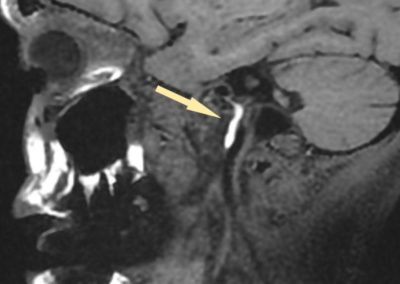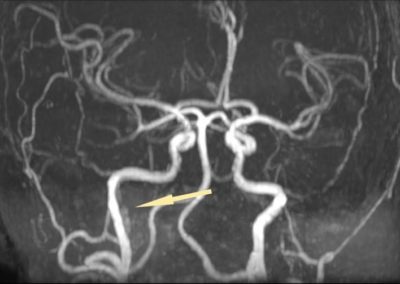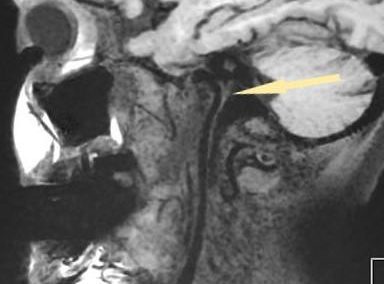Mrs C. Carotid dissection and Covid‑19
Name of patient
Disease type

Personal story
Mrs C. is a French clinical psychologist, 51-years-old.
Without any serious pre-existing medical problem (only thyroid resection for thyroiditis) she suddenly and spontaneously had a right cervical pain at the end of February 2020.
At that time in France no health rules against the SARS-CoV-2 epidemic were put in place (first French cases were declared at the end of January).
She spent a week working with this pain without any other signs (neurologic, vascular, respiratory). After her husband’s advice (he’s a clinical radiologist), she had a cervical and brain Magnetic Resonance Imaging (MRI) scan, which showed a limited right internal carotid dissection (intramural arterial hematoma) just under skull brain (figures 1-2-3) without brain damage (no ischemia or infarct). An anticoagulation therapy was instituted in emergency by the neurologist team.
A week after this diagnosis she developed over the course of a few hours fever, asthenia, olfaction dysfunction, without any respiratory signs. Diagnosis of Covid-19 was confirmed by PCR test. After 3 days of rest, all clinical signs completely disappeared.
She could come back to work but at that time the first nationwide lockdown was implemented on 17th March by the French government (until the 11th of May 2020).
In July 2020, Mrs C.’s MRI follow-up showed the hematoma resolution.
Radiological Findings
Dissection is a longitudinal parietal tear in the arterial vessel wall resulting in intramural haemorrhage collecting in the lumen (figure 1) that can cause progressive narrowing or occlusion of the vessel, or creation of a double lumen, which can result in emboli (1).
Although rare, dissection of neck vessels is the most common cause of brain ischemic attacks in young subjects (about 20% of strokes in patients 25 years old and younger). It can be spontaneous or post-traumatic (after severe trauma-polytraumatized or not: spinal manipulation, sports practice …). It can be favoured by an underlying angiopathy. Infectious contexts can be favouring (2), so Sars-Cov 2 has been suspected in various and recent publications (3,4).
The internal carotid artery is the most common site of these dissections (68%), the vertebral artery less often (27%). Dissection seats can be multiple in 5% of cases.
The Ultrasound-Doppler study is limited to accessible vascular lesions (proximal parts of the internal carotid artery) and less effective for distal dissections of the internal carotid artery and vertebral arteries.
Angio-scanner and Angio-MRI (imaging dedicated to vascular studies) allow an anatomical study of the entire path of the supra-aortic arterials trunks (from the heart to brain) with satisfactory sensitivities and specificities of dissection diagnosis (5). However, MRI has the advantage of allowing the most effective study of the cerebral ischemic resonance (by special diffusion and perfusion sequences). Invasive arteriography (Seldinger and selective arterial catheterism) no longer has a place in the diagnostic stage.
Diagnostic and therapeutic management (anticoagulation, recalibration) must of course be immediate to avoid ischemic cerebral repercussions when possible.
Imaging monitoring of the dissected arterial wall is then essential and is best done in MRI (resolution of the wall hematoma (figure 4) or on the contrary progression of stenosis-occlusion-formation of a pseudo-aneurysm).
D.Carrié
French Radiologist, MD
References
- JL Mac Carthy and Al. Ischemic Infarction in Young Adults: A Review for Radiologists RadioGraphics 2019; 39:1629–1648
- B. Guillon and al. Infection and the risk of spontaneous cervical artery dissection: a case-control study
Stroke 2003;34:e79-e81 - M. Morassi and al. Stroke in patients with COVID-19: Clinical and neuroimaging characteristics Neurosciences letters 743 (2021) 135564
- MV Rezin et al. Multisystem Imaging Manifestations of COVID-19, Part 2: From Cardiac Complications to Pediatric Manifestations
RadioGraphics 2020; 40:1866–1892



